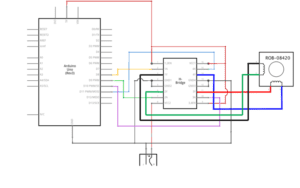In this recitation, we continued exploring Arduino functions with motors by playing with higher voltages. For this session we had to build two circuits and one drawing machine, in which I was only able to finish the two circuits. We switched out the Servo motor for a more high powered stepper motor, which gave us more potential to power heavier and faster objects with the Arduino.
Components:
1 * 42STH33-0404AC stepper motor
1 * SN754410NE ic chip
1 * power jack
1 * 12 VDC power supply
1 * Arduino kit and its contents
2 * Laser-cut short arms
2 * Laser-cut long arms
1* Laser-cut motor holder
2 * 3D printed motor coupling
5 * Paper Fasteners
1 * Pen that fits the laser-cut mechanisms
Paper
Step 1: Build the Circuit

Despite its initial difficulty understanding what went where with the first circuit, building it actually wasn’t a big problem. I just followed the circuit and plugged it into the lines it was supposed to go. I asked a fellow to double check the circuits so that I don’t fry my computer and the Arduino board, and then after, by pasting the code from the Arduino website I was able to make the motor make one full rotation.
The video is attached below:
Step 2: Control Rotation with Stepometer
It is the second step in which I started to run into problems. Firstly, I had a little trouble trying to attach the stepometer to the circuit, because at first the ground and power was not connected properly, and I had to look through all the circuit wires to understand what I did wrong. The code was rather straight forward, as I just changed the code values to reflect the pin numbers on the circuitboard and changed the stepper seconds and rotation to match that of the stepometer.
However, when I was trying to reconnect stepometer to the power supply I pretty dumbly assumed that the IC chip would be the power supply, not the power line I had connected to the Arduino. So once I connected the stepometer to the IC chip, which was then connected to the Arduino, the Arduino immediately started to smoke, and even when I immediately yanked it out as fast as I could the Arduino was damaged and would not work for a while.
At first I wasn’t sure if it was my code that was giving me the error messages, so I asked a fellow to help, and it turns out when the Arduino started smoking it fried its ability to connect with my laptop. So at first I tried to fix the Arduino, and a fellow and I worked for a while to get it working, only to confirm the chip was fine, but the board was fried and had to be fixed at a later time. So I borrowed an Arduino board from the Equipment Room and checked the circuits, connected the right power supply, checked the code, and once I did that the circuit worked.
Here is a video below:
Unfortunately, completing the second circuit took up all the time in recitation, so going forward next time, to prevent something like this from happening, I would make sure to triple check with the fellows anything I am unsure about: such as where the powerline would go to, so then a mistake like this does not happen again. Especially with such high voltages, it is dangerous to make mistakes and carry on when you are unsure, and next time I will make sure to not only consult the circuit photo more closely, but also feel more comfortable reaching out to the the fellows and professors when I am unsure with what I am doing.
Documentation Questions
- I would like to build a machine that could make food based on a certain type of emotion the user was feeling? I think that would be a really cool kind of digital art, especially if the food made was expressive in some way, probably in terms of colors or nostalgia factor when considering different recipes. The actuators used would be really interesting, because cooking requires precision yet deft movement, and I have yet to use any in class that were able to do both really well. So I would curious to see how programming an actuator to perform not only the finer details of cutting up food or measuring ingredients yet being able to like, swing a pan up and down or perform stir fry. The senses would mainly use smell, as I feel smell in combination with emotion would be an interesting combination of human responses that can be used to manipulate “art” as the food is meant to create a sense of nostalgia or is supposed to match a very specific emotion from the user.
- What immediately caught my eye is Chico MacMurtrie’s The Drumming and Drawing Subhuman. Mostly because it looks really cool, but I think the idea of actuators being used to create human like features of struggle and emotion are really cool. It is similar to what I did in recitation because the skeleton looks like it is on fire and is melting (haha), but also I think like the motors I used in recitation, there is something very human like about the clunkiness of my motor along with his. An actuator’s movements can struggle enough that MacMurtrie used the effect to make organic drumming movements. The motions had to be, according to the artist, primal, struggling to the stand, attempting to hit a drum — the actuators have to be able to swing a large range but can not function fast or that well. The emotionality of the movements compared with the coldness of the skeletal robots evoke a powerful reaction from the viewer.